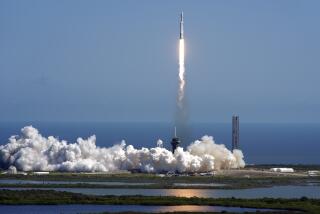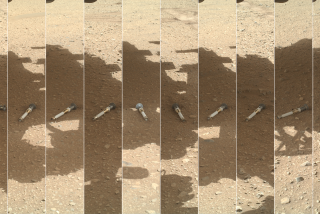Scientists Hope to Make a Splash on a Jupiter Moon
- Share via
Rocket scientists at NASA’s Jet Propulsion Laboratory in Pasadena are proposing to send a hit-and-run mission to Jupiter’s icy moon Europa in hopes of finding signs of life: A small spacecraft would drop a 20-pound ball onto the moon’s surface, sending up a plume of icy material that the mother ship would then pass through, soaking up samples like a flying sponge.
JPL researchers are scheduled to formally present their proposal today at a meeting in San Juan Capistrano devoted to Europa. That moon is also the next major stop for the Galileo spacecraft, which is now touring the Jovian system.
Researchers are scrambling to learn about Europa because its solid ice surface may well hide one of the solar system’s most hospitable locations for life--a large underground ocean heated by volcanic vents.
As one of the largest and closest of Jupiter’s 16 moons, Europa gets squashed and stretched by huge gravitational forces. A person standing on Europa, said planetary geoscientist Doug Nash, would feel the surface rise and fall as much as 10 yards. The heat generated by this motion “has to escape somehow,” he said.
Most likely, it oozes out in underwater volcanoes. Similar deep-sea vents on the ocean floor of Earth have proved fertile spawning grounds for strange and unexpected life forms, such as giant tube worms that feed on sulfur fumes.
The San Juan Capistrano conference will bring together experts on Earth’s oceans with experts in planetary science--a first, says JPL’s Torrence Johnson, who heads the Galileo science team. “It ought to be fun,” he said, as well as a chance for cross-fertilization among experts in very different fields.
JPL engineer Henry Harris devised the so-called Ice Clipper mission as a way to get to Jupiter relatively cheaply--and spend as little time as possible in the planet’s dangerous radiation belt. Rather than land a spacecraft on Europa, the mission would bring a piece of the moon back to the spacecraft.
If Ice Clipper is chosen to fly by a NASA screening committee, it would launch in 2000 and return to Earth by 2012, JPL scientists say.
The $250-million spacecraft would cruise toward Jupiter for six years before releasing its artificial meteor--a pint-size version of the colossal Shoemaker-Levy comet that crashed into Jupiter in 1994. A cloud of ice and vapor should rise 30 miles or more in Europa’s thin, cold atmosphere.
Seconds after impact, the mother ship would change its trajectory slightly, dipping into the cloud to collect particles of Europa dust. Some particles will be soaked up by an array of aerogels--an extremely light porous material--and brought back to Earth. Other bits of matter in the cloud can be sampled directly by sensors on the mother ship, their composition radioed directly back to Earth.
Above all, researchers want to know exactly what--other than ice--coats Europa’s surface. Intriguing images beamed back by the Galileo spacecraft suggest that enormous ice sheets are moving about on a layer of slush, producing dark cracks and fissures. But the nature of the dark material is a mystery. Said Nash: “Is it silicon? Is it sulfur? Is it carbon?”
Carbon compounds are the basis of life on Earth, so the discovery of carbon is always promising, if not definitive evidence of biological activity. But the combination of possible carbon compounds, a liquid ocean, and volcanic activity puts Europa high on the list of possibly inhabited worlds, Nash said.
Harris hopes that his system would also be applied to other moons and asteroids. He says creativity comes naturally: Before coming to JPL 16 years ago, he made his living singing and playing piano in Las Vegas.
His idea is drawing mixed reactions from scientists. “It’s a clever idea, but not necessarily a doable one,” said Nash, of the San Juan Institute, which is hosting the meeting.
Johnson and others, however, aren’t sure that drive-through missions can accomplish the same kind of science as Galileo-type orbiters. “In a fast, cheap mission, you can’t do more than one thing,” he said. “In this kind of one-shot deal, there’s no guarantees as to what you’ll get.”
The meeting is jointly sponsored by the National Science Foundation’s Ocean Sciences Program and NASA’s Exobiology Program.
(BEGIN TEXT OF INFOBOX / INFOGRAPHIC)
The Ice Clipper
Some scientists believe that one of Jupiter’s moons, Europa, may hide one of the solar system’s most hospitable locations for life below its solid ice surface--a large underground ocean heated by volcanic vents. Here is a rough description of a proposed mission, dubbed Ice Clipper, to gather ice and dust from Europa for study back on Earth.
1) A $250-million spacecraft launched toward Jupiter in 2000 would arrive at Europa in 2008 and release an artificial meteor--perhaps a 20-poind metal ball--over the icy moon.
2) The impact would produce a cloud of ice and vapor rising 30 miles or more in Europa’s thin, cold atmosphere. The mother ship would dip into the faux cloud and collect particles of Europa, like fly paper passing through a cloud of flies.
3) Some particles would be soaked up by an array of aerogels (an extremely light porous material) and then returned to Earth by 2012 in a specially designed recovery and return module.
4) Other bits of matter gathered in the cloud would be sampled directly by sensors on the mother ship, with their composition radioed directly back to Earth.
Source: NASA; Illustration based on Stardust comet probe






